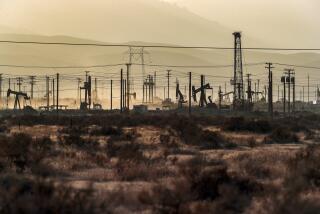In Mississippi, a power plant is designed to shape the future of coal

- Share via
DE KALB, Miss. — Looming like a spaceship over pine and sweet-gum forest, the high-tech power plant under construction in rural Kemper County is a $5-billion wager on an energy future that includes coal.
The Kemper plant is scheduled to open this year as the first in the United States to ramp up technology to remove carbon dioxide emissions on a large scale. If it works as planned, up to 65% of the plant’s potential carbon dioxide emissions would be removed.
But if its progress is any indication, building a coal plant that can sharply reduce greenhouse gas pollution is a white-knuckle ride. The project is five months behind schedule and more than $2 billion over budget. The cost overruns have increased electricity bills in southeastern Mississippi, stirred stiff opposition from consumers and environmentalists, and contributed to a downgrade in the credit rating outlook for Southern Co., the plant’s parent corporation.
Related: Duke Energy receives 5 more citations weeks after coal ash spill
The U.S. Energy Department has spent $270 million on the project — part of $3.4 billion in federal stimulus funds allocated to carbon-capture demonstration projects since 2009 — yet it remains unclear, according to some analysts familiar with the project, whether the Kemper plant will work as planned.
The carbon-capture plant and four others on the drawing boards, including one near Bakersfield, are cited by Obama administration officials as evidence that coal can remain part of the president’s “all of the above” energy strategy. But many power companies and environmentalists think the administration’s proposed standards for greenhouse gas emissions would all but eliminate coal power despite huge investments in the new technology.
Dalia Patino Echeverri, an assistant professor of energy systems and public policy at Duke University, said the new rules would “put coal at a huge disadvantage,” noting that the technology to capture and store carbon dioxide “is still an expensive, uncertain proposition.”
Six years into the project, Southern is careful not to tout Kemper as a model that could easily be replicated. “To say there is a one-size-fits-all, that what we do here is applicable someplace else, would probably not be accurate,” said Amoi Geter, a spokeswoman for Mississippi Power, the Southern Co. subsidiary building the plant.
In Kemper County, northeast of Jackson, Southern found an unusual cluster of advantages. The plant stands at the mouth of a mine for lignite coal, a cheap fuel. Kemper will use inexpensive treated wastewater in its power generation process. Most importantly, it will make money from the removed carbon dioxide by piping it to two companies that will inject it into the ground to force oil from old wells.
Coal-fired power plants are the single largest source of heat-trapping carbon dioxide in the United States. In September, the Environmental Protection Agency proposed standards for new power plants that would limit carbon dioxide output from coal plants to 1,100 pounds per megawatt hour, down from the current industry average of about 1,800 pounds, a reduction that would require new technology such as that being attempted at Kemper.
Those rules could accelerate the already dramatic shift to natural gas. The price of gas has fallen sharply as hydraulic fracturing, or fracking, has increased supplies, and plants can be built quickly and cheaply.
But natural gas prices have been wildly volatile in the past, and the United States has the world’s largest reserves of recoverable coal, a fuel whose prices have historically been low and relatively stable.
“If you think that it’s a sound bet that coal will be part of the future of the country, if you have an interest in coal, and companies like Southern do, it makes good business sense to develop technology that lets you use the resource in way that is socially acceptable,” said Edward S. Rubin, a professor of engineering and public policy at Carnegie Mellon University in Pittsburgh.
The 582-megawatt Kemper project will generate enough electricity to serve 189,000 customers. A smaller plant is under construction in Saskatchewan, Canada. About 24 power plants around the world are in the planning phase, according to the Carbon Capture and Sequestration Technologies Program at the Massachusetts Institute of Technology.
Carbon-capture technology is not new. Refineries and some U.S. power plants have used it on a small scale. Gasified coal, the fuel Kemper will burn, is used at other plants too. But Kemper has a new gasification system. Its operating plan significantly scales up and combines all the technology.
“There won’t be clear takeaways for the rest of industry until the plant starts operating,” Rubin said. “The first takeaway will be, does it work?”
A leader in carbon-capture research, Southern intends for Kemper to replace older coal plants. The project was wreathed in high hopes. Former Energy Secretary Steven Chu wrote, “This project is of national importance because it provides a viable option for using our abundant coal resources in a cost-effective and clean manner.”
High cranes swing over the construction site, which is a tangle of bright silver galvanized steel pipes around the chambers where the carbon is captured. Kemper is far larger than conventional coal plants, in part because a chemical plant and refinery-like towers have been grafted onto it. If successful, Kemper will strip away 65% of the carbon, significantly more than the proposed EPA requirement of about 40%.
At Kemper, pulverized coal will be turned into gas by combusting the fuel in a chamber where low oxygen levels will keep it from burning. The gas will be piped into tall columns, where it will rise through a fine rain of the solvent Selexol, which binds carbon dioxide molecules to it.
The carbon dioxide will be separated from the Selexol by reducing the pressure in a chamber that holds the mixture, similar to the way carbon dioxide is released from a soda can when it is opened. The coal gas will be burned to make steam that drives turbines.
Given the novelty of weaving together the carbon capture and new coal gasification technology and building it on a large scale, it remains unknown whether the plant will operate reliably, without frequent forced outages, and also manage to cut emissions at planned levels, Rubin said.
The project was budgeted for $2.4 billion, or about $1 billion more than a conventional coal plant. But Kemper’s cost ballooned to more than $5 billion because of changes in design, miscalculations about the amount of materials needed and bad weather that slowed work.
Southern wrote down $1 billion, but Mississippi Power’s customers are still carrying some costs. The state Legislature passed a law that allows Southern to recoup costs from ratepayers before the plant produces power and another that lets Mississippi Power issue $1 billion in bonds. Kemper now accounts for about 16% of an average monthly residential electric bill.
The fate of the other four planned U.S. carbon-capture plants remains unclear, said Howard J. Herzog, a senior research engineer with the MIT Energy Initiative. The Energy Department is financing between 10% and 50% of their costs, but if construction does not begin by mid-2015, when the funding runs out, the projects would lose that money.
“There’s a realistic chance that one or all may never get built,” Herzog said.
Some experts, like Echeverri, believe the price of carbon-capture technology will come down. But the risks and high costs of being a trailblazer mean “no one wants to be among the first 10 plants,” she said. “If your choice is that you can start a plant with proven technology like a natural gas plant or unproven expensive technology, you will build a gas plant.”
More to Read
Sign up for Essential California
The most important California stories and recommendations in your inbox every morning.
You may occasionally receive promotional content from the Los Angeles Times.














